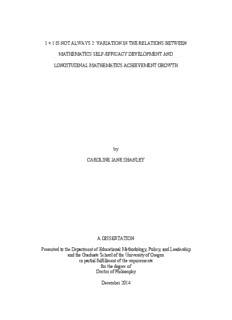
1 + 1 is not always 2 PDF
Preview 1 + 1 is not always 2
1 + 1 IS NOT ALWAYS 2: VARIATION IN THE RELATIONS BETWEEN MATHEMATICS SELF-EFFICACY DEVELOPMENT AND LONGITUDINAL MATHEMATICS ACHIEVEMENT GROWTH by CAROLINE JANE SHANLEY A DISSERTATION Presented to the Department of Educational Methodology, Policy, and Leadership and the Graduate School of the University of Oregon in partial fulfillment of the requirements for the degree of Doctor of Philosophy December 2014 DISSERTATION APPROVAL PAGE Student: Caroline Jane Shanley Title: 1 + 1 Is Not Always 2: Variation in the Relations Between Mathematics Self- Efficacy Development and Longitudinal Mathematics Achievement Growth This dissertation has been accepted and approved in partial fulfillment of the requirements for the Doctor of Philosophy degree in the Department of Educational Methodology, Policy, and Leadership by: Gina Biancarosa Chairperson Ben Clarke Core Member Mark Van Ryzin Core Member Joanna Goode Institutional Representative and J. Andrew Berglund Dean of the Graduate School Original approval signatures are on file with the University of Oregon Graduate School. Degree awarded December 2014 ii © 2014 Caroline Jane Shanley iii DISSERTATION ABSTRACT Caroline Jane Shanley Doctor of Philosophy Department of Educational Methodology, Policy, and Leadership December 2014 Title: 1 + 1 Is Not Always 2: Variation in the Relations Between Mathematics Self- Efficacy Development and Longitudinal Mathematics Achievement Growth Creating an educational program that results in positive post-secondary and science, technology, engineering, and mathematics (STEM)-oriented outcomes for all students is a national goal and federal policy directive. Recent research has shown that in addition to measures of academic proficiency, intra- and interpersonal skills are important factors in college and career readiness. Likewise, mathematics proficiency is an important skill for successful STEM outcomes and post-secondary success, but these achievements and outcomes frequently vary based on demographic characteristics. This study utilized data from the Early Childhood Longitudinal Study, Kindergarten Class of 1998-99 to examine the relationships between mathematics achievement growth in Grades K–1 and Grades 3–8, mathematics self-efficacy development in Grades 3–8, and demographic factors including sex, socioeconomic status (SES), and race/ethnicity. Various models of mathematics achievement growth were tested, and the relationships between both early and middle grades mathematics achievement growth and self-efficacy development were also explored. Sex, SES, and race/ethnicity differences in both mathematics achievement growth and self-efficacy development were discovered, and findings were consistent with familiar achievement gaps favoring white and Asian males iv from above median SES households. In particular, SES was found to be a ubiquitous factor in both mathematics achievement and self-efficacy development, and sex moderated some of the relationships between mathematics achievement and self-efficacy. Implications for future research, instructional design, and intervention development are discussed. v CURRICULUM VITAE NAME OF AUTHOR: Caroline Jane Shanley GRADUATE AND UNDERGRADUATE SCHOOLS ATTENDED: University of Oregon, Eugene, OR San Francisco State University, San Francisco, CA Whitman College, Walla Walla, WA DEGREES AWARDED: Doctor of Philosophy, Educational Leadership, 2014, University of Oregon Master of Arts, Special Education, 2011, San Francisco State University Bachelor of Arts, History, 2000, Whitman College AREAS OF SPECIAL INTEREST: Mathematics Education Research Design & Quantitative Methodology PROFESSIONAL EXPERIENCE: Doctoral Fellow; Lead Author & UTFG Lead; KinderTEK Intervention Author; Cognitive Study Co-Coordinator, University of Oregon, Center for Teaching and Learning (CTL), 2011-present Early Elementary Mathematics Content Expert; Item Reviewer, Southern Methodist University, Research in Mathematics Education, 2013-present Research & Analytics: Reliability Analyst, Program Administrator Intern University of Oregon, Educational Policy Improvement Center (EPIC), 2012 & 2014 Resource Specialist, Mild/Moderate Disabilities, K-12, Oakland Unified School District, Oakland, CA, 2000-2011 GRANTS, AWARDS, AND HONORS: Educational Methodology, Policy, and Leadership Department Travel Grant Award, 2013 & 2014 vi Graduate Teaching Fellow, University of Oregon, Center on Teaching and Learning, 2013-2014 Statistics Institute on Mathematics Equity Participant Award, American Education Research Association, 2012 Doctoral Research Fellowship, Center on Teaching and Learning, 2011-2013 PUBLICATIONS: Clarke, B., Doabler, C. D., Nelson-Walker, N., & Shanley, L. (in-press). Effective early numeracy and whole number concepts instruction for all learners: Translating research to practice. Intervention in School & Clinic. Clarke, B., Nelson, N., & Shanley, L. (in-press). Mathematics fluency: more than the weekly timed test. In K.D. Cummings & Y. Petscher (Eds.). Fluency metrics in education: Implications for test developers, researchers, and practitioners. New York: Springer. Biancarosa, G., & Shanley, L. (in-press). What is fluency? In K.D. Cummings & Y. Petscher (Eds.). Fluency metrics in education: Implications for test developers, researchers, and practitioners. New York: Springer. Carlson, S. E., Biancarosa, G., Basaraba, D. L., & Shanley, L. (2014). Supporting readers in science. ASCD Express, 9(13). Basaraba, D. L., Biancarosa, G., Carlson, S. E., & Shanley, L. (2014). Teaching students to read like historians. ASCD Express, 9(13). vii ACKNOWLEDGMENTS Many thanks to Dr. Gina Biancarosa for her assistance in preparation of this manuscript and for her invaluable mentorship and support. In addition, I would like to thank Dr. Ben Clarke for his support of this project and Drs. Mark Van Ryzin and Joanna Goode for their thoughtful input. viii For my dad, who taught me that attitude is everything; for Ryan, who always makes me think; and for my beautiful biscuit, whose brilliance and potential is unmatched. ix TABLE OF CONTENTS Chapter Page I. INTRODUCTION .................................................................................................... 1 II. LITERATURE REVIEW ........................................................................................ 3 Mathematics Achievement ..................................................................................... 3 Early Grades ..................................................................................................... 4 Middle Grades .................................................................................................. 5 Self-Efficacy .......................................................................................................... 5 Group Differences .................................................................................................. 8 Sex.................................................................................................................... 9 Socioeconomic Status (SES) ............................................................................ 9 Race and Ethnicity ........................................................................................... 10 Summary .......................................................................................................... 11 Current Study ......................................................................................................... 13 III. METHOD .............................................................................................................. 15 Participants & Procedures ...................................................................................... 15 Measures ................................................................................................................ 16 Data Analyses ........................................................................................................ 20 Sample Weights ............................................................................................... 29 Missing Data .................................................................................................... 30 IV. RESULTS .............................................................................................................. 33 Group Differences .................................................................................................. 40 x
Description: